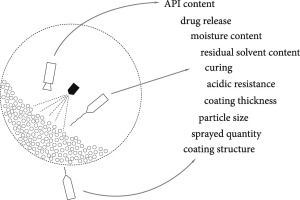- Home
- Blog
- News
- Basics
- Sources
- Agencies, Regulatory & Organisations
- CERSI Excipients Browser
- Excipient Report
- Excipient DMF List
- EXCiPACT Certified Companies
- Excipient Documentation
- Excipient EINECS Numbers
- Excipient E-Numbers
- FDA Inactive Ingredient List
- FDA GRAS Substances (SCOGS) Database
- IPEC Americas
- USP - U.S. Pharmacopeia
- Definitions
- Whitepapers / Publications
- Supplier
- Services
- Media
- Events
- 1st pharmaexcipients Poster Award
- Event Calendar
- Events featured by pharma-excipients
- 4th Annual Formulation & Drug Delivery Congress
- DDF Summit
- ExcipientFest Americas
- ExcipientFest Asia
- Global CompliancePanel
- International Conference and Exhibition on Pharmaceutics & Novel Drug Delivery Systems
- Formulation & Drug Delivery USA Congress
- Laboratory Medicine 2018
- Making Pharmaceuticals Europe
- Making Pharmaceuticals Exhibition
- Pharma Integrates
- PharmaExcipients China @CPhI China
- TTC Technology Training Center
- Jobs
- Online Sourcing
- Contact
01. October 2018
The occurrence of protein aggregation during bioprocessing steps such as purification, formulation and fill-finish, impacts yield and production costs, and must be controlled throughout themanufacturing process. Understanding aggregation mechanisms and developing mitigating strategies are imperative to ensure the clinical efficacy of the protein drug product and to reduce costs. Thiscommentary reflects on recent progress made in the field of monoclonal antibody (mAb) aggregation with...
01. October 2018
In this study, a set of 24 experiments was designed to understand the combined effect of different process parameters, i.e. material feed rate, liquid-to-solid (L/S) ratio, screw speed, and screw configuration on the residence time distribution, granule morphology, and particle size distribution in twin screw wet granulation of microcrystalline cellulose. It was shown that residence times were longer at higher L/S and lower screw speeds. However, the most dominant effect on mean residence time...
20. May 2018
The influence of particle morphology and size of alpha-lactose monohydrate on dry granules and tablets was studied. Four different morphologies were investigated: Two grades of primary crystals, which differed in their particle size and structure (compact crystals vs. agglomerates). The materials were roll compacted at different specific compaction forces and changes in the particle size distribution and the specific surface area were measured. Afterwards two fractions of granules were pressed...
11. May 2018
Improve Compliance by Optimizing the Taste of Active Compounds Dietary supplements for athletes and balanced additives for all age groups must, above all, possess one property: they have to taste good. Consumer acceptance is essential for long-term use and thus for the desired, positive effect on performance and health. However, many active substances do not taste nice. Their tastes range from sulphurous to fishy to astringent and bitter. Alpha-lipoic acid, caffeine or resveratrol are just a...
27. March 2018
Particle surface modification is becoming a vital strategy in the pharmaceutical industry for “difficult to formulate” APIs. Most surface modification techniques, however, alter innate particle properties either chemically or physically. These surface modification technologies involve the use of elevated temperatures, high pressures, and/or solvents, making these processes highly unsuitable for unstable APIs that are degraded when exposed to such conditions. Aston Particle Technologies...
29. November 2017
Purpose Characterisation of powder flow is important for pharmaceutical processing and manufacturing. This work aims at a better understanding of how fractal particle and bulk properties affect the static and dynamic flow of excipients. Methods Traditional methods of flowability testing, e.g. the angle of repose or the flow through an orifice, were complemented by avalanching in a rotational drum. Dynamic image analysis provided a fractal contour line dimension of the powder bulk in the drum...
14. October 2017
Over the last two decades, regulatory agencies have demanded better understanding of pharmaceutical products and processes by implementing new technological approaches, such as process analytical technology (PAT). Process analysers present a key PAT tool, which enables effective process monitoring, and thus improved process control of medicinal product manufacturing. Process analysers applicable in pharmaceutical coating unit operations are comprehensibly described in the present article. The...
06. October 2017
In the field of nasal drug delivery, among the preparations defined by the European Pharmacopoeia, nasal powders facilitate the formulation of poorly water-soluble active compounds. They often display a simple composition in excipients (if any), allow for the administration of larger drug doses and enhance drug diffusion and absorption across the mucosa, improving bioavailability compared to nasal liquids. Despite the positive features, however, nasal products in this form still struggle to...
16. September 2017
Abstract We aimed to understand the factors controlling mechanical particle coating using polymethacrylate. The relationship between coating performance and the characteristics of polymethacrylate powders was investigated. First, theophylline crystals were treated using a mechanical powder processor to obtain theophylline spheres (<100 μm). Second, five polymethacrylate latexes were powdered by spray freeze drying to produce colloidal agglomerates. Finally, mechanical particle coating was...
28. April 2017
The rising demand for pharmaceutical particles with tailored physico-chemical properties has opened new markets for the spray drying technology especially for solubility enhancement, improvement of inhalation medicines and stabilization of biopharmaceuticals. Despite this, the literature on spray drying is scattered and often does not address the fundamental principles underpinning the robust development of pharmaceutical products. It is therefore necessary to present a clearer picture of the fi








